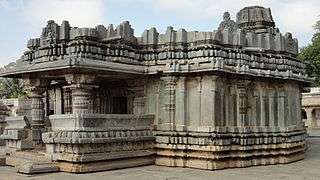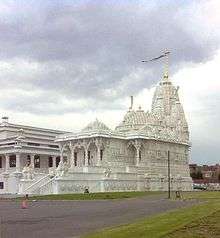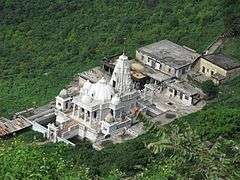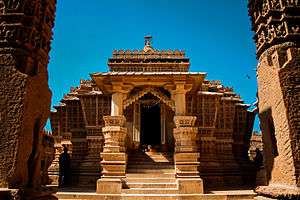Parshvanatha
| Parshvanatha | |
|---|---|
| 23rd Jain Tirthankara | |
|
Image of Tīrthankara Parshvanatha (Victoria and Albert Museum, 6th–7th Century) | |
| Venerated in | Jainism |
| Predecessor | Neminatha |
| Successor | Mahavira |
| Symbol | Snake[1] |
| Height | 9 cubits (13.5 feet)[2] |
| Age | 100 years |
| Color | Blue |
| Personal information | |
| Born |
c. 9th–7th century[3] Varanasi |
| Died |
c. 8th–7th century[3] Shikharji |
| Parents |
|
| Part of a series on |
| Jainism |
|---|
 |
|
Jain prayers |
|
Ethics |
|
Major sects |
|
Festivals |
|
|
Parshvanatha (Pārśvanātha), also known as Parshva (Pārśva), was the 23rd of 24 Tirthankaras (ford-maker, teacher) of Jainism.[4] He is the earliest Jain Tirthankara who is generally acknowledged as a historical figure.[5][6] His biography is uncertain, with Jain sources placing him between the 9th and 8th century BC, and historians stating he may have lived in 8th or 7th century BC. Along with Mahavira, Rishabhanatha and Neminatha, Parshvanatha is one of the four Tirthankaras who attracts the most devotional worship among the Jains. His iconography is notable for the serpent hood over his head, and his worship often includes Dharanendra and Padmavati – the serpent god and goddess of Jainism.
Parshvanatha is said in Jain texts to have been born in Benares (Varanasi, India), renounced the worldly life and founded an ascetic community. He is credited with starting the tradition of "fourfold restraint" for monks – don't kill, don't steal, don't lie and don't own property. Svetambara texts, such as section 2.15 of Acaranga Sutra, state that Mahavira's parents were followers of Parshvanatha,[7] linking Mahavira to a pre-existing theology and as a reformer of pre-existing Jain mendicant tradition. Mahavira expanded the scope of Parshvanatha's first four restraints, with his ideas on Ahimsa (non-violence) and added the fifth monastic vow of celibacy in the practice of asceticism.[8] Parshvanatha, in contrast, according to them, had not required celibacy,[9] and had allowed the wearing of simple outer garments by monks.[10] The differences between the ideas of Parshvanatha and Mahavira, have been one of the many historic foundations behind the disputes between the two major Jain sub-traditions – Svetambaras and Digambaras.[11][12][13] The Digambara sect disagrees with the Svetambara interpretations,[14] and they reject the theory of difference in Parshvanatha and Mahavira's teachings.[12]
Parshvanatha's popularity among Jains is widespread, according to Paul Dundas – a professor of Sanskrit known for his publications on Jainism.[15] Parshva is popularly seen as a ford-maker who removes obstacles and has the capacity to save.[15] Parshvanatha died on Mount Sammeta (Madhuban, Jharkhand) along the River Ganges basin, a place that has been an important pilgrimage site for all sub-traditions within Jainism.[16][17]
Historicity
Parshvanatha is generally accepted as a historical figure.[18][19] According to Dundas, the Jain texts such as the section 31 of Isibhasiyam, provide circumstantial evidence that he was a real person in ancient India.[18] Historians such as H. Jacobi have accepted him as a historical figure, because his Chaturyama Dharma (four vows) is mentioned in the Buddhist scriptures.[20]
Despite the accepted historicity, some parts of historical claims such as the link between him and Mahavira, whether Mahavira renounced within the ascetic tradition previously started by Parshvanatha, and other biographical details have led to varying scholarly conclusions.[21] He is claimed in Jain texts to have been 13.5 feet tall.[2]
His biography is legendary, with Jain texts stating that he preceded Mahavira by about 250 years and that he lived one hundred years.[22][3] Mahavira is placed between c. 599 – c. 527 BC in the Jain tradition, and accordingly Parshva is placed by Jains between c. 872 – c. 772 BC.[22][23][24] According to Dundas, outside of the Jain tradition, historians date the Mahavira as about contemporaneous with the Buddha in the 5th-century BC, and accordingly the historical Parshva, based on the c. 250-year gap, is placed in 8th or 7th century BC.[3]
Doubts about his historicity are supported by the most ancient Jain texts, which predominantly present Mahavira with sporadic mention of ancient ascetics and teachers without specific names, such as in sections 1.4.1 and 1.6.3 of the Acaranga Sutra.[25] The earliest layer of Jaina literature on cosmology and "Universal History" pivots around only two Jinas, the Adinatha (Rishabhanatha) and Mahavira. In the later layer of Jaina literature, stories about Parshvanatha and Neminatha Tirthankaras appear in texts, with the Kalpasutras being the first known text. However, these Jaina texts present the biographies of Tirthankaras with unusual non-human body dimensions, the characters lack individuality or depth, and the brief descriptions of three Tirthankara are largely modeled after Mahavira.[26] The Kalpasutras is the most ancient known Jain text with the entire list of twenty-four, but it merely lists twenty, and for three including Parshvanatha the description is very brief in comparison to Mahavira.[26][27] The early archeological findings such as the statues and reliefs found near Mathura, lack the iconography such as the lion or serpent emblem, possibly because these ideas evolved in Jainism later.[26][28]
Biography in Jain tradition

Life before renunciation
Parshvanatha was born on the tenth day of the dark half of the month of Paush to King Asvasena and Queen Vamadevi of Benares (now Varanasi).[30][18][31] He belonged to the Ikshvaku dynasty.[32][33] Before he was born, Jain texts state he was ruling as a god Indra in the 13th heaven of Jain cosmology.[34] While he was in the womb of his mother, gods came from heavens and performed the garbha-kalyana (enlivening the fetus).[35] His mother dreamt fourteen auspicious dreams, an indicator in the Jain tradition that a Tirthankara was about to be born.[35] When he was reborn in the world of men, state the Jain texts, the thrones of all the Indras trembled in different heavens. They descended to the earth to celebrate his janma-kalyana (the auspiciousness of his birth).[36]
Parshvanatha was born with blue-black skin color, grew up into a strong and handsome boy, playing with the gods of water, as well as the gods of hills and trees.[36] At age eight, he began practicing the twelve basic vows of the adult Jain householder.[36][note 1]
Parshvanatha lived as a prince of Benaras (now Varanasi). According to Digambara school, Parshva never married, but the texts of the Shwetambara school preach that he married Prabhavati, the daughter of Prasenajit (King of Kusasthala).[38][39] Heinrich Zimmer translated a Jain text as stating that sixteen-year-old Parshvanatha refused to marry when his father suggested he do so, and instead entered the practice of meditations perceiving that the "soul is its own only friend".[40]
Renunciation
At the age of 30, on the 11th day of the moon in its bright cycle of the Pausha month (December/January), he renounced the world to become a monk.[41][42] He meditated for 84 days before attaining Kevala Jnana under a Dhaataki tree near Benaras.[43] As he performed his ascetism, state the Jain texts, lions and fawns played around him.[42][note 2]
- Omniscience and Moksha
On the 14th day of the moon in its waning cycle of the Chaitra month (March/April), Parshvanatha gained omniscience.[45] The gods built a samavasarana, or a teaching hall for him, so that he could share his knowledge with his followers.[46]
After preaching for 70 years, he died at the age of 100.[18] His death is traditionally called by Jains as Moksha or separation of soul from cycles of rebirths.[31] He died atop Shikharji.[note 3] This mountainous area is known contemporaneously as the Parasnath Hills in northern Jharkhand.[49] Parshvanatha has been referred by Jains as purisādāṇīya ('beloved of the people').[50][51][52]
Previous births
The Jain mythologies present the legends of previous lives of Parshvanatha, his rebirths as human or animal with different names, the maturing of his soul towards inner harmony, in a manner similar to those found in other Indian religions.[53][note 4] A few illustrative prior rebirths of Parshvanatha include:[55]
- Marubhuti – The prime minister of King Aravinda named Visvabhuti had two sons, elder one named Kamath and younger one named Marubhuti (Parshvanatha). Kamath committed adultery with the wife of Marubhuti. The king learnt about the adultery and asked Marubhuti how his brother should be punished. Marubhuti suggested forgiveness. Kamath went into a forest, became an ascetic, and thereby garnered special demonic powers to take revenge. Marubhuti went to the forest to invite his brother back home, but Kamath killed Marubhuti by crushing him with a stone. Marubhuti was one of the earlier births of Parshvanatha.[56]
- Elephant – He was then reborn as an elephant because of the "violence of the death and distressing thoughts he harbored at the time of his previous death".[57] His name was Vajraghosha (Thundering Voice of Lightning) and he lived in the forests of Vindyachal.[58] Kamath meanwhile was reborn as a serpent.[58] King Aravinda, after the death of his minister Marubhuti, renounced his throne and was leading an ascetic life. When an angry elephant came near the ascetic Aravinda, he saw that the elephant was none other than Marubhuti reborn. Aravinda asked the elephant to give up "sinful acts, remove his demerits from the past, realize that injuring other beings is the greatest sin, and to begin practicing the vows".[57] The elephant realized his error, became calm, and bowed to the feet of Aravinda. One day, when the elephant went to a river to quench his thirst, the serpent attacked him and he died the peaceful death of absolute renunciation, this time without distressing thoughts.[59]
- Sasiprabha – Vajraghosha was reborn as the deity Sasiprabha (literally, splendor or lord of the moon)[note 5] in the twelfth heaven surrounded by abundant pleasures. Sasiprabha, however, did not let the pleasures distract him, he did not relapse into hedonism, and continued his simple regular pious ascetic life in the heaven.[59]
- Agnivega – Deity Sasiprabha died and was then reborn as prince Agnivega (strength of fire). He ascended the throne of his father, but one day he met a sage. The sage discussed the impermanence of everything and the significance of a spiritual life. Agnivega immediately realised the importance of religious pursuits, the worldly life lost its charm for him, and he renounced it to lead an ascetic life, joining the monastic community of the sage who had visited him.[59] Agnivega the ascetic meditated in the Himalayas, reducing his karmic attachments to external world. He was bitten by a snake (Kamath reborn again); the poison burned inside him, but the experience did not disturb his inner peace, and he sublimely accepted death.[63]
The dead Agnivega was reborn, states Zimmer, as a god with a life of "twenty two oceans of years", while the serpent went to the sixth hell.[63] Ultimately, the soul of Marubhuti-Vajraghosa-Sasiprabha-Agnivega was once again born as Parshvanatha. In this life, he saved serpents from torture and death, and the serpent god Dharnendra and goddess Padmavati thereafter protected him, ever-present in his iconography.[22][64]
Disciples
Jain texts give different inconsistent accounts of the disciples of Parshvanatha. According to the Kalpa Sūtra, a Śvētāmbara text, Parshvanatha had 164,000 śrāvakas (male lay followers) and 327,000 śrāvikās (female lay followers) and 16,000 sādhus (monks) and 38,000 sādhvīs (nuns).[65][55] According to Svetambara tradition, he had eight ganadharas (chief monks): Śubhadatta, Āryaghoṣa, Vasiṣṭha, Brahmacāri, Soma, Śrīdhara, Vīrabhadra and Yaśas.[49] After his death, the Svetambara believe that ganadhara Śubhadatta became the head of the monastic order. He was then succeeded by Haridatta, Āryasamudra and Keśī.[41]
Digambara tradition, in contrast, states that Parshvanatha had 10 ganadharas, such as in the Digambara text Avasyaka niryukti. They believe that Svayambhu was the chief male mendicant (sadhu). Svetambara texts such as Samavayanga and Kalpa-sutra mention Pushpakula as the chief female mendicant (aryika, sadhvi) among the female followers of Parshvanatha,[65] whereas the Digambara text Tiloyapannati states she was Suloka or Sulocana.[39]
The Nirgranthas (fetter-less) monastic tradition started by Parshvanatha was influential in ancient India, with the parents of Mahavira belonging to it as lay householders supporting the ascetics.[66]
Teachings: similarities and differences with Mahavira
According to the Svetambara Jain tradition, Parsva and the ascetic community he established followed a Fourfold Restraint.[67][68] In contrast, Mahavira stipulated five Great Vows as a mode of ascetic initiation.[67][69] This difference, and why the difference, has been often discussed in Svetambara Jain texts.[70] For example, the Uttardhyayana Sutra,[71][72] a Svetambara canonical text, presents Kesin as a follower of Parsva and Gautama as a disciple of Mahavira, discussing which is the true doctrine: the Fourfold Restraint or the five Great Vows.[73] Gautama states that there are outward differences, according to Dundas, and these differences are "because the moral and intellectual capabilities of the followers of the ford-makers have differed".[74] According to Wendy Doniger, Parshvanatha allowed monks to wear clothes, while Mahavira recommended giving up even clothes and practicing ascetic life in nudity – a practice that has been one of several differences between Digambara and Svetambara traditions of Jainism.[75][76]
According to the Śvētāmbara texts, the four restraints of Parshvanatha were Ahimsa, Aparigraha, Achaurya and Satya.[22] The ancient Buddhist canonical texts, such as Samaññaphala Sutta that mention Jain ideas and Nigantha Nataputta (Mahavira), also only state four restraints rather than the five vows found in later texts of Jainism. This has led scholars such as Hermann Jacobi to state that at the time the Mahavira and the Buddha met, the Buddhists knew of only four restraints in the Parshva tradition called caujjama dhamma.[14] Further scholarship, states Dundas, suggests a more complex uncertain situation, because some of the earliest Jain literature such as section 1.8.1 of Acaranga Sutra connects Mahavira with just three restraints (non-violence, non-lying, non-possession).[77]
The "less than Five vows" view in Svetambara canonical texts is however not accepted by the Digambaras, a tradition whose canonical texts have been long lost and who do not accept Svetambara Jain texts as canonical to Digambara tradition.[14] Digambara do have a vast literature dated to later centuries, which explains their disagreement with the Svetambara interpretations.[14] Prafulla Modi, for example, rejects the theory of difference in Parshvanatha and Mahavira's teachings.[12] Champat Rai Jain states that Svetambara texts also insist on celibacy (sexual abstinence) for their monks, which is the fifth vow in Mahavira's teachings, and therefore there must not have been a difference in the teachings of Parshvanatha and Mahavira.[78]
According to Padmanabh Jaini, the Digambaras interpret the "fourfold" part contextually as referring "not to four specific vows" but "four modalities" which was properly elaborated by Mahavira into five vows.[79] Western and in part some Indian scholarship, states Jaini, "has been essentially Svetambara scholarship" and has largely ignored Digambara literature related to this controversy about Parshvanatha and Mahavira teachings.[79] According to Dundas, the medieval era Jain literature such as by the 9th-century Silanka suggests that the practice of "not using another's property without their explicit permission" and "celibacy" were interpreted as a part of "non-possession".[77]
In literature

- Uvasagharam Stotra is an adoration of the twenty-third Tīrthankara Parshvanatha written by Acharya Bhadrabahu.
- Acharya Jinasena's Mahapurāṇa include Ādi purāṇa and Uttara-purāṇa. It was completed by Acharya Gunabhadra, the disciple of Jinasena in the 8th century C.E. In Ādi purāṇa, life events of Rishabhanatha, Bahubali and Bharata are detailed out.[80]
- Kalpa Sūtra contains biographies of the Jain Tirthankaras, notably Parshvanatha and Mahavira.
- Guru Gobind Singh has penned a life history of Parshvanatha in a composition called the Paranath Avtar, which is included in the Dasam Granth.[81]
Iconography
Parshvanatha is a popular tirthankar in Jainism who attracts devotional worship (bhakti), along with Adinatha, Shantinatha, Neminatha and Mahavira.[82][83] Parshvanatha is believed to have the power to remove obstacles and save.[84]
Parshvanatha is usually depicted in Lotus position or Kayotsarga posture. Statues and paintings of Parshvanatha show his head shielded by a multi-headed serpent fanned like an umbrella. The snake emblem of Parshvanatha is also found carved or stamped below his legs as an icon identifier. His iconography is usually accompanied by Dharnendra and Padmavati, the snake god and goddess of Jainism.[22][64]
The serpent hood iconography is not unique to Parshvanatha. It is also found above the icons of the 7th of 24 Tirthankaras named Suparshvanatha, but with a minor difference.[85] The serpent hood above Suparshvanatha features five heads, while a seven- or more headed serpent is found in Parshvanatha icons. The statues of both Tirthankaras with serpent hoods have been found in different parts of India, such as Uttar Pradesh and Tamil Nadu, and these are dated to between 5th and 10th-century CE.[86][87]
Archeological sites and medieval era Parshvantha iconography found in temples and Jain cave arts include scenes and Yaksha. The Digambara and Svetambara traditions show differences in their historic icons. For example, Svetambara artworks show Parshvanatha with both serpent hood and a Ganesha-like Yaksha, while Digambara artworks show him with serpent hood and Dhranendra, but no Ganesha-like deity.[88][89] According to Umakant Premanand Shah, such a display of Hindu gods such as Ganesha as Yaksha, and Indra as serving Parshvanatha were a way to assign them to a subordinate position.[90]
- Museum of Oriental Art, 2nd-century CE excavated in Uttar Pradesh
 5th century, Satna museum, Madhya Pradesh
5th century, Satna museum, Madhya Pradesh 6th century, Uttar Pradesh
6th century, Uttar Pradesh- Akota Bronze, 7th century, Honolulu Academy of Arts
 Copper Idol inlaid with silver and gemstones, 10th century, LACMA
Copper Idol inlaid with silver and gemstones, 10th century, LACMA- 8th century from Mathura, Östasiatiska museet
- 11th century, Maharaja Chhatrasal Museum
- Brass Idol from 8th century, Ethnological Museum of Berlin
.jpg) 10th century, Asian Civilisations Museum
10th century, Asian Civilisations Museum%2C_xii_secolo.jpg) 12th century idol from Karnataka, Art Institute of Chicago
12th century idol from Karnataka, Art Institute of Chicago- Jain chaubisi of Parshavanatha, Norton Simon Museum
.jpg) 1813 engraving
1813 engraving
Colossal statues
- Navagraha Jain Temple: This temple features the tallest statue of Parshvanatha. The monolithic idol of Parshvanatha is in kayotsarga posture. The statue is 61 feet (18.6 m) tall and stands on a 48-foot (14.6-m) high pedestal (109 feet total). The statue and pedestal weigh about 185 tons.[91]
- Gopachal Hill: Gopachal Hill has rock-cut Jain statues built between 1398 A.D. and 1536 A.D. Here, a colossus of Parshvanatha in padmasan posture, 47 feet in height and 30 feet in breadth is present in one of the caves. This statue is the tallest idol of Parshvanatha in Lotus position.[92][93]
- Parshvanatha Basadi: This Basadi was built in Shravanabelagola during 10th century and enshrines an 18-feet-tall image of Parshvanatha in kayotsarga posture.[94]
- Parshvanatha Basadi, Halebidu was built by Boppadeva in 1133 AD. It enshrines an 18-feet-tall image of Parshvanatha made of black granite stone in kayotsarga posture.[95]
- A 31-feet-tall monolithic statue of Parshvanatha in kayotsarga posture was installed in 2011 at Vahelna Jain Temple.
- Naugaza Digambar Jain temple was built in 922 AD during the reign of the Gurjara-Pratihara ruler Mahipala I. It was once a Jain temple but only a 5.33 m-tall statue of Parshvanatha remains here.
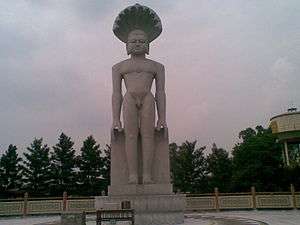 31 feet Parshvanatha Vahelna Statue
31 feet Parshvanatha Vahelna Statue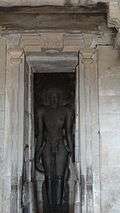 18 feet idol of Parsvanatha in Parsvanatha Basadi at Shravanabelgola
18 feet idol of Parsvanatha in Parsvanatha Basadi at Shravanabelgola 17.5 feet statue of Parshavanatha at Naugaza Digambar Jain Temple, Alwar, Rajasthan
17.5 feet statue of Parshavanatha at Naugaza Digambar Jain Temple, Alwar, Rajasthan
Temples
- Shikharji (Sammet Sikhar) in Jharkhand
- Mirpur Jain Temple
- Shri Shankeshwar Tirth[55]
- Andeshwar Parshwanath in Rajasthan
- Lal Mandir in Chandni Chowk, Delhi
- Bada Gaon
- Kallil Temple, Kerala
- Navagraha Jain Temple in Hubli, Karnataka
- Ahi Kshetra
See also
Notes
- ↑ According to Zimmer, the Tattvarthadhigama Sutra state the twelve householder vows to be: (1) don't kill any being, (2) don't lie, (3) don't use another's property without permission, (4) be chaste, (5) limit your possessions, (6) take a perpetual and daily vow to go only certain distances and take only certain directions, (7) avoid useless talk and action, (8) don't think sinful acts, (9) limit diet and enjoyments, (10) worship at fixed times in the morning, noon and evening, (11) fast on some days, (12) give charity by donating knowledge, money and such everyday.[37]
- ↑ The Jain mythology describes gods of various heavens attempting to distract or harm Parshvanatha, but the serpent god Dharanendra and goddess Padmavati guard him as he journeys to omniscience.[44]
- ↑ Some texts refer to the place as Mount Sammeta.[47] This place is revered in Jainism because 20 out of 24 Jinas are believed to have died here.[48]
- ↑ Jataka tales, for example, tell the stories of the rebirths and previous lives of the Buddha.[54]
- ↑ He is also known as Chandraprabha,[60] and found in Buddhist and Hindu mythologies.[61] The deity is the eighth of the twenty-four forbearers in Jain cosmology.[62]
References
Citations
- ↑ Tandon 2002, p. 45.
- 1 2 Sarasvati 1970, p. 444.
- 1 2 3 4 Dundas 2002, pp. 30–31.
- ↑ Fisher 1997, p. 115.
- ↑ Heehs 2002, p. 90.
- ↑ Jaini 2001, p. 62.
- ↑ Heehs 2002, pp. 90–91.
- ↑ Chapple 2011, pp. 263–267.
- ↑ Kenoyer & Heuston 2005, pp. 96–98.
- ↑ Editors of Encyclopaedia Britannica (2000). Students' Britannica India, Volume 4: Miraj to Shastri. Popular Prakashan. p. 158. ISBN 978-0-85229-760-5.
- ↑ Jones & Ryan 2006, p. 211.
- 1 2 3 Umakant P. Shah 1987, p. 5.
- ↑ Dundas 2002, pp. 31–33.
- 1 2 3 4 Jaini 2000, pp. 27–28.
- 1 2 Dundas 2002, p. 33.
- ↑ Dundas 2002, pp. 30–31, 221.
- ↑ Wiley 2009, p. 148.
- 1 2 3 4 Dundas 2002, p. 30.
- ↑ Zimmer 1953, p. 182–183, 220.
- ↑ Kailash Chand Jain 1991, p. 11.
- ↑ Dundas 2002, pp. 30–33.
- 1 2 3 4 5 Britannica 2009.
- ↑ Zimmer 1953, p. 183.
- ↑ Martin & Runzo 2001, pp. 200–201.
- ↑ Dundas 2002, p. 39.
- 1 2 3 Dundas 2002, pp. 39–40.
- ↑ Umakant P. Shah 1987, p. 83–84.
- ↑ Umakant P. Shah 1987, pp. 82–85, Quote: "Thus the list of twenty-four Tirthankaras was either already evolved or was in the process of being evolved in the age of the Mathura sculptures in the first three centuries of the Christian Era.".
- ↑ Jacobi 1964, p. 271.
- ↑ Zimmer 1953, p. 184.
- 1 2 Sangave 2001, p. 104.
- ↑ Ghatage 1951, p. 411.
- ↑ Deo 1956, p. 60.
- ↑ Zimmer 1953, pp. 183–184.
- 1 2 Zimmer 1953, p. 194–196.
- 1 2 3 Zimmer 1953, p. 196.
- ↑ Zimmer 1953, p. 196 with footnote 14.
- ↑ Kailash Chand Jain 1991, p. 12.
- 1 2 Umakant P. Shah 1987, p. 171.
- ↑ Zimmer 1953, pp. 199–200.
- 1 2 von Glasenapp 1999, pp. 24–28.
- 1 2 Zimmer 1953, p. 201.
- ↑ Danielou 1971, p. 376.
- ↑ Zimmer 1953, pp. 201–203.
- ↑ Zimmer 1953, pp. 202–203.
- ↑ Zimmer 1953, pp. 203–204.
- ↑ Jacobi 1964, p. 275.
- ↑ Cort 2010, pp. 130–133.
- 1 2 Kailash Chand Jain 1991, p. 13.
- ↑ Jacobi 1964, p. 271 with footnote 1.
- ↑ Kailash Chand Jain 1991, pp. 12–13.
- ↑ Schubring 1964, p. 220.
- ↑ Zimmer 1953, p. 187–188.
- ↑ Jataka, Encyclopaedia Britannica (2010)
- 1 2 3 Clines, Gregory M. (2017). "Pārśvanātha (Jainism)". In Sarao, K. T. S.; Long, Jeffery D. Buddhism and Jainism. Encyclopedia of Indian Religions. Springer Netherlands. pp. 867–872. doi:10.1007/978-94-024-0852-2_702. ISBN 978-94-024-0851-5.
- ↑ Zimmer 1953, p. 186–187.
- 1 2 Zimmer 1953, p. 189.
- 1 2 Zimmer 1953, p. 189–190.
- 1 2 3 Zimmer 1953, p. 190.
- ↑ Umakant P. Shah 1987, p. 107, Quote: In Paimacariyam, Candraprabha is called Sasiprabha".
- ↑ Paul Williams 2005, pp. 127–130.
- ↑ Coulter 2013, p. 121.
- 1 2 Zimmer 1953, p. 191.
- 1 2 Cort 2010, pp. 26, 134, 186.
- 1 2 Jacobi 1964, p. 274.
- ↑ Dalal 2010, p. 220.
- 1 2 Dundas 2002, pp. 30–32.
- ↑ Jaini 1998, p. 17.
- ↑ Price 2010, p. 90.
- ↑ Jaini 1998, pp. 13–18.
- ↑ Jaini 1998, p. 14.
- ↑ Jaini 2000, p. 17.
- ↑ Dundas 2002, pp. 31–32.
- ↑ Dundas 2002, p. 31.
- ↑ Doniger 1999, p. 843.
- ↑ Long 2009, pp. 62–67.
- 1 2 Dundas 2002, p. 283 with note 30.
- ↑ Champat Rai Jain 1939, p. 102–103.
- 1 2 Jaini 2000, pp. 28–29.
- ↑ Upadhye 2000, p. 46.
- ↑ Dasam Granth, S.S. Kapoor, Page 17
- ↑ Dundas 2002, p. 40.
- ↑ Cort 2010, pp. 86, 95–98, 132–133.
- ↑ Dundas 2002, pp. 33, 40.
- ↑ Cort 2010, pp. 278–279.
- ↑ Tirthankara Suparsvanatha in Kayotsarga, or Standing Meditation, Posture and Protected by a Five-Headed Naga, Harvard Art Museum, Cambridge, USA; Alt Archive: Arthur M. Sackler Museum
- ↑ Pal, Huyler & Cort 2016, p. 204.
- ↑ Brown 1991, pp. 105–106.
- ↑ Pal 1995, p. 87.
- ↑ Umakant P. Shah 1987, pp. 220–221.
- ↑ Hubli gets magnificent 'jinalaya'. The Hindu, 6 January 2009.
- ↑ Jain.org.in
- ↑ http://gwalior.nic.in/Tourism.html
- ↑ http://anandbharat.com/bg/2016/10/22/shravanabelagola-a-unique-destination/
- ↑ "Parsvanatha Basti, Halebid". Archaeological Survey of India. Archived from the original on 18 November 2017. Retrieved 10 June 2017.
Sources
- Brown, Robert L. (1991), Ganesh: Studies of an Asian God, State University of New York Press, ISBN 978-0-7914-0656-4
- Chapple, Christopher K (2011), Andrew R. Murphy, ed., The Blackwell Companion to Religion and Violence, John Wiley, ISBN 978-1-4443-9573-0
- Cort, John E. (2010), Framing the Jina: Narratives of Icons and Idols in Jain History, Oxford University Press, ISBN 978-0-19-538502-1
- Coulter, Charles Russell (2013), Encyclopedia of Ancient Deities, Routledge, ISBN 978-1-135-96390-3
- Danielou, A (1971), L'Histoire de l'Inde Translated from French by Kenneth Hurry, ISBN 0-89281-923-5
- Deo, Shantaram Bhalchandra (1956), History of Jaina monachism from inscriptions and literature, Pune: Deccan College Post-Graduate and Research Institute
- Dalal, Roshen (2010), The Religions of India: A Concise Guide to Nine Major Faiths, Penguin books, ISBN 978-0-14-341517-6
- Doniger, Wendy, ed. (1999), Encyclopedia of World Religions, Merriam-Webster, ISBN 0-87779-044-2
- Dundas, Paul (2002) [1992], The Jains (Second ed.), Routledge, ISBN 0-415-26605-X
- Parshvanatha: Jaina Saint, in Encyclopaedia Britannica, Editors of the Encyclopaedia Britannica, 2009
- Fisher, Mary Pat (1997), Living Religions: An Encyclopedia of the World's Faiths, London: I.B.Tauris, ISBN 1-86064-148-2
- Ghatage, A.M. (1951), "Jainism", in Majumdar, R.C.; Pusalker, A.D., The Age of Imperial Unity, Bombay
- Heehs, Peter (2002), Indian Religions: A Historical Reader of Spiritual Expression and Experience, New York University Press, ISBN 978-0-8147-3650-0
- Jacobi, Hermann (1964), Max Muller (The Sacred Books of the East Series, Volume XXII), ed., Jaina Sutras (Translation), Motilal Banarsidass (Original: Oxford University Press)
- Jain, Champat Rai (1939), The Change of Heart
- Jain, Kailash Chand (1991), Lord Mahāvīra and His Times, Motilal Banarsidass, ISBN 978-81-208-0805-8
- Jaini, Padmanabh S. (1998) [1979], The Jaina Path of Purification, Delhi: Motilal Banarsidass, ISBN 81-208-1578-5
- Jaini, Padmanabh S. (2001), Collected Papers on Buddhist Studies, Motilal Banarsidass, ISBN 978-81-208-1776-0
- Jaini, Padmanabh S., ed. (2000), Collected Papers On Jaina Studies (First ed.), Delhi: Motilal Banarsidass, ISBN 81-208-1691-9
- Jones, Constance; Ryan, James D. (2006), Encyclopedia of Hinduism, Infobase Publishing, ISBN 978-0-8160-7564-5
- Long, Jeffery D. (2009), Jainism: An Introduction, I. B. Tauris, ISBN 978-1-84511-625-5
- Kenoyer, Jonathan M.; Heuston, Kimberley Burton (2005), The Ancient South Asian World, Oxford University Press, ISBN 978-0-19-522243-2
- Martin, Nancy M.; Runzo, Joseph (2001), Ethics in the World Religions, Oneworld Publications, ISBN 978-1-85168-247-8
- Pal, Pratapaditya (1995), Ganesh, the Benevolent, Marg Publications, ISBN 978-81-85026-31-2
- Pal, Pratapaditya; Huyler, Stephen P.; Cort, John E. (2016), Puja and Piety: Hindu, Jain, and Buddhist Art from the Indian Subcontinent, University of California Press, ISBN 978-0-520-28847-8
- Price, Joan (2010), Sacred Scriptures of the World Religions: An Introduction, Bloomsbury Academic, ISBN 978-0-8264-2354-2
- Radhakrishnan, S. (1923). Indian Philosophy. The Macmillan Company.
- Sangave, Vilas Adinath (2001), Facets of Jainology: Selected Research Papers on Jain Society, Religion, and Culture, Mumbai: Popular Prakashan, ISBN 978-81-7154-839-2
- Sarasvati, Swami Dayananda (1970), An English translation of the Satyarth Prakash, Swami Dayananda Sarasvati
- Schubring, Walther (1964), Jinismus, in: Die Religionen Indiens, 3, Stuttgart
- Shah, Umakant Premanand (1987), Jaina-rūpa-maṇḍana: Jaina iconography, Abhinav Publications, ISBN 81-7017-208-X
- Tandon, Om Prakash (2002) [1968], Jaina Shrines in India (1 ed.), New Delhi: Publications Division, Ministry of Information and Broadcasting, Government of India, ISBN 81-230-1013-3
- Titze, Kurt (1998). Jainism: A Pictorial Guide to the Religion of Non-Violence. Motilal Banarsidass. ISBN 978-81-208-1534-6.
- Upadhye, Dr. A. N. (2000), Mahāvīra His Times and His philosophy of life, Bharatiya Jnanpith
- von Glasenapp, Helmuth (1999), Jainism: An Indian Religion of Salvation [Der Jainismus: Eine Indische Erlosungsreligion], Shridhar B. Shrotri (trans.), Delhi: Motilal Banarsidass, ISBN 81-208-1376-6
- Wiley, Kristi L. (2009) [1949], The A to Z of Jainism, 38, Scarecrow Press, ISBN 978-0-8108-6337-8
- Williams, Paul, ed. (2005), Buddhism: Critical Concepts in Religious Studies, Routledge, ISBN 978-0-415-33226-2
- Zimmer, Heinrich (1953) [April 1952], Campbell, Joseph, ed., Philosophies Of India, London, E.C. 4: Routledge & Kegan Paul Ltd, ISBN 978-81-208-0739-6
External links

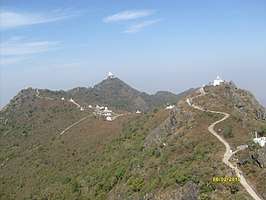
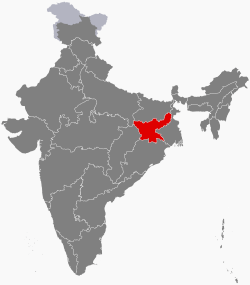
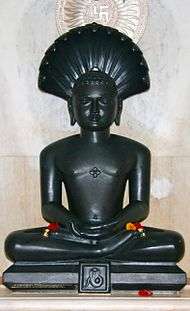
_(8638423582).jpg)
